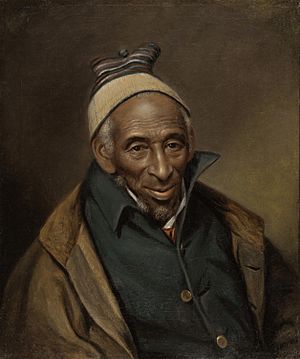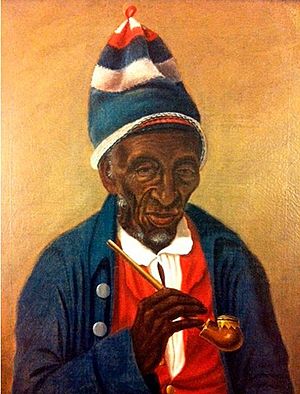Yarrow Mamout facts for kids
Quick facts for kids
Yarrow Mamout
|
|
|---|---|
| Mamadou Yarrow | |

Portrait of Yarrow Mamout (Muhammad Yaro), 1819 by Charles Willson Peale
|
|
| Born | c.1736 |
| Died | January 19, 1823 (aged 86–87) |
| Occupation | Entrepreneur |
Yarrow Mamout (born around 1736 – died January 19, 1823) was an amazing person who lived in Georgetown, Washington, D.C.. He was once enslaved but became a successful businessman and owned property. Yarrow was a Fulani Muslim who was educated. He finally gained his freedom in 1796 after being enslaved for 44 years. Two famous artists, James Alexander Simpson and Charles Willson Peale, painted his portrait. Peale's painting is now in the Philadelphia Museum of Art.
Contents
Yarrow's Early Life
Yarrow was born in West Africa around 1736. His African name was likely Mamadou Yarrow. The name Yarrow Mamout became well-known through the diary of the artist Charles Willson Peale.
In 1752, when he was about 16 years old, Yarrow was taken from Guinea on a slave ship called Elijah. He was brought to Annapolis, Maryland, where he was enslaved.
Yarrow was part of the Fulani people. He could speak the Fula language and could read and write Arabic. He also knew some English. Historians believe his family in Africa was wealthy and well-educated.
Life in Slavery
When Yarrow arrived in Maryland, he was sold to Samuel Beall. Beall owned a large farm in Takoma Park. Yarrow worked as Beall's personal helper. Later, he worked for Beall's son, Brooke.
By 1790, Yarrow had moved with Brooke Beall to Georgetown. He started working for wages, meaning he could earn money for his skills. Brooke Beall made him give over the money he earned during the day. However, Yarrow was allowed to keep the money he earned from working at night.
Yarrow was very skilled and worked many different jobs. He made bricks, burned charcoal, wove baskets, drove carts, and loaded ships. He worked very long hours to save enough money to buy his own freedom.
After 44 years of being enslaved, Yarrow finally became free in 1796. He was about 60 years old. Brooke Beall had died, and Yarrow's owners decided he was too old to work. They set him free.
Right away, Yarrow spent £20 to buy the freedom of his seven-year-old son, Aquilla. Aquilla had been born into slavery on a nearby farm. We don't know much about Aquilla's mother.
Life as a Free Man
Yarrow was very smart with money. He saved $200 and became one of the first people to invest in the Columbia Bank of Georgetown. This bank was very successful.
In 1800, Yarrow bought a piece of land in Georgetown. It was located at 3324 Dent Place NW. At the time, it was valued at $30. He built a log house on this land. By 1816, his property was worth $500. Yarrow lived comfortably on the money he earned from his bank investments.
Yarrow remained a very religious Muslim throughout his life. He prayed regularly and did not eat pork.
On March 23, 1821, Yarrow loaned $170.85 to a white businessman named William Hayman. This money helped Hayman buy a warehouse. After Yarrow died, Hayman did not pay back the loan.
In 1843, Nancy Hillman, who was the daughter of Yarrow's sister, went to court to get the money back. In 1850, she received $300 from the sale of the warehouse.
Yarrow Mamout passed away on January 19, 1823. He was around 86 years old. According to his obituary, written by Charles Willson Peale, he was buried in a corner of his yard where he used to pray. An archaeological dig in 2015 did not find any remains.
Peale's obituary for Yarrow was printed in the Gettysburg Compiler. It was then copied by 38 other newspapers across the United States. This shows how special Yarrow's life story was. He was an African Muslim who had been enslaved but became a successful businessman and property owner.
Yarrow's Family
Two years after Yarrow's death, his son Aquilla bought a farm in Washington County, Maryland. He moved there with his wife, Mary "Polly" Turner. Mary was a midwife and had also been enslaved.
The town of Yarrowsburg, Maryland, was named in Mary's honor. Her great-grandnephew, Robert Turner Ford, went on to graduate from Harvard University in 1927.
Portraits of Yarrow
We know of two paintings of Yarrow Mamout. They were painted by James Alexander Simpson and Charles Willson Peale.
Peale painted his portrait in 1819, when Yarrow was 83 years old. Some people thought he was much older, even 134! Simpson painted Yarrow's portrait in 1822.
Simpson's painting is kept at the District of Columbia Public Library. Peale's painting is at the Philadelphia Museum of Art. Simpson's portrait was shown at the National Portrait Gallery in 2016. In this painting, Yarrow wears a hat that looks like a kufi.
See Also
- Fula Americans
- Omar ibn Said
- Ayuba Suleiman Diallo
- Islam in the United States


